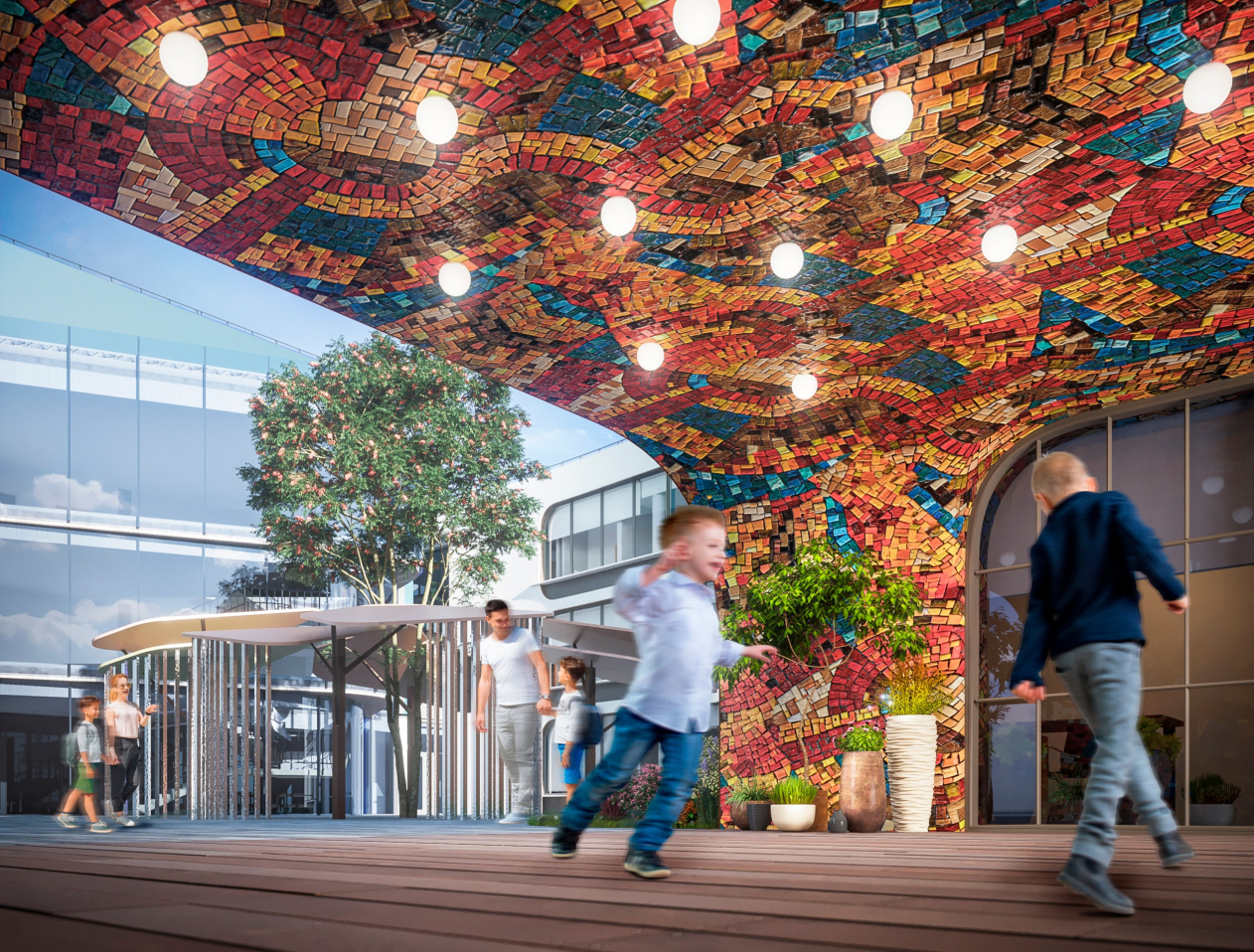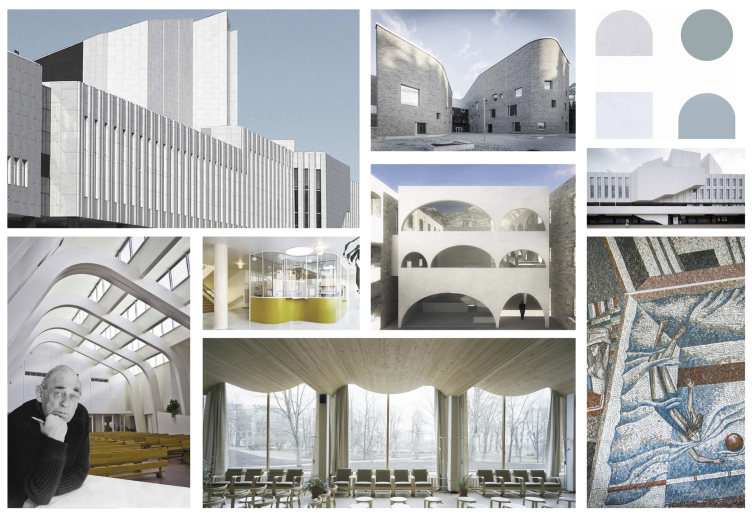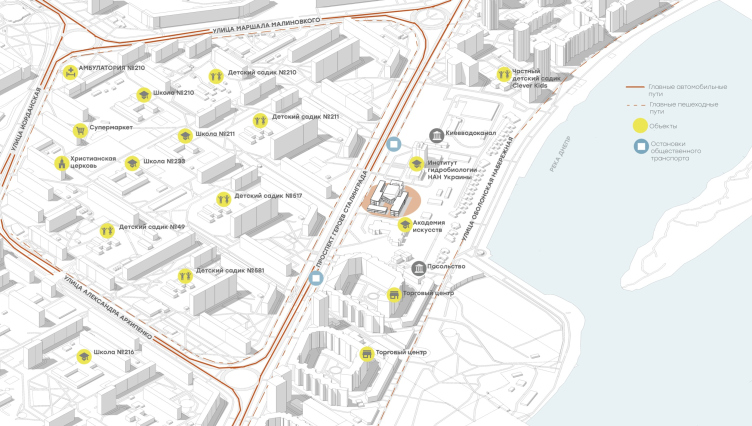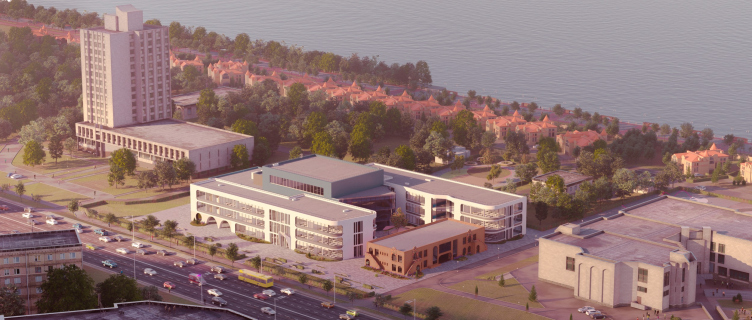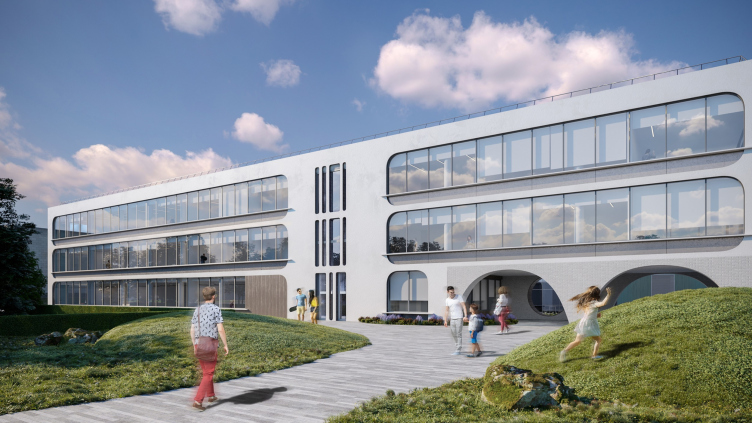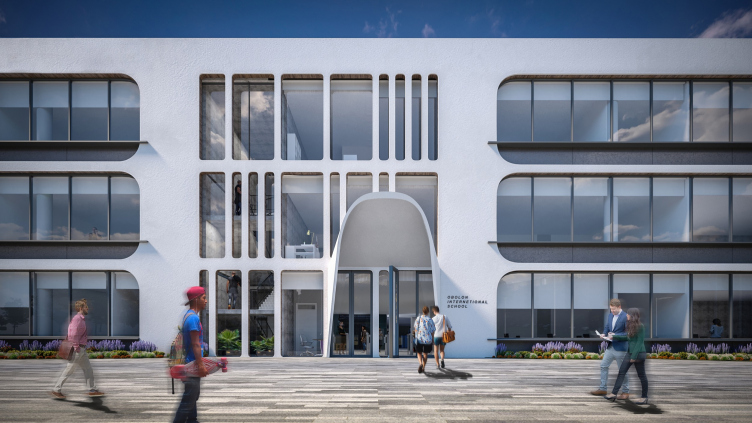At the last Arch Moscow festival, the Archimatika booth was dedicated to the concept of aesthetic education. The company has quite a lot to say on this subject: the school in the district of Obolon will become Kiev’s fourth private school that it designs. The previous three –Gymnasium A+, Pechera International School, and the Academy of Modern Education – have won scores of architectural awards, setting the trend for private education in Ukraine. Initially, the architects had yet to convince the client that they could create more than just spacious classrooms full of light – and now the bar is raised even higher with each new project.
“International Obolon School”
Copyright: © Archimatika
According to the concept of aesthetic education, architecture of the school building inevitably becomes part of the school program: as long as we live, we remember the walls, the corridors and the yard of the school that we went to – this influence must be taken into account and made as positive as possible. One of the founders of the company, Alexander Popov, explains that the environment of the school must be comfortable and comprehensible not only to the children that go to it, but to the teachers and the school management as well – otherwise, the portraits of the great authors, the rugs, and the bookshelves will constantly be at odds with the architects’ ideas. And, second, the space must be filled with images. In this sense, Archimatika is critical of the “golden standard” of the Scandinavian schools, which have become popular over the last twenty years, because of their neutral and reserved nature. “If you place a child inside a white cube and tell them that this is a school, this space is not going to teach them anything because it will be alien to them, and, furthermore, a potentially creative individual will turn into a vandal because they will want to paint this space, to customize it in some way” – Alexander Popov believes.
As for the space that is rich in imagery, it not only offers a choice between staying in a secluded place or socializing, working or taking a rest, looking out the window commanding a garden view or a sports field, but also unobtrusively teaches the students the right proportions, artistic taste, archetypal shapes, and an ability to appreciate and respect other people’s art. Such environment, based on the dialogue with the child and his needs, gives you more chances to bring up an individual who is more likely to make a positive difference to the social, engineering, or cultural systems in the future.
“International Obolon School”
Copyright: © Archimatika
Friendship with Neighbors
So! The new school designed by Archimatika will be built in the district of Obolon, which in the 1970-80’s took on a modernist structure being developed with gigantic housing complexes, mostly of a hexagonal form, and in the 2000’s got high-rise housing complexes overlooking the Dnipro River. Due to the long and broad strip of the waterfront, Obolon became a popular place where people of Kiev come for recreation.
The land site where the school will be built is situated in the “public” city block between the waterfront and the Stalingrad Heroes Avenue, one of the three main streets of this area that follows the bend of the Dnipro. The school’s nearest neighbors are the Academy of Arts and the Institute of Archaeology and Hydrology, both buildings presenting fine examples of late Soviet modernism.
“International Obolon School”
Copyright: © Archimatika
Immersing themselves into context, the architects refrained from the idea of opposing the building against its neighbors, and decided to create something that would resonate with the surroundings as a tribute to the Soviet town planning tradition. The task turned out to be far from simple – according to the architects’ metaphor, the team “needed rolls of tracing paper” in order to immerse themselves into the atmosphere of the Khrushchev’s “thaw” past, and find the right image of the school, just as positive, and focused on the future. At this stage, the architects came up with the general volumes, the parabolic entrance arch, the configuration of the windows, and the open spaces under the buildings.
“International Obolon School”
Copyright: © Archimatika
However, it turned out that the client was not ready for revisited Soviet modernism, counting on the Scandinavian model. Then the architects added a few details – wood, colorful porcelain tiles under the windows, a green “curtain” of the theater, and a mosaic. The play proposed by the architects, in which the northern whiteness and minimalism in the spirit of Alvaro Aalto meets warm Mediterranean motifs, and the same time starting a meaningful dialogue with the neighboring Soviet architecture, was something that satisfied all of the stakeholders of the project.
“International Obolon School”
Copyright: © Archimatika
The School Town
The future educational complex will also include a kindergarten and two independent schools, “French” and “German”, each with an administration and educational program of its own. They will share a common yard and a building that will host a cafeteria, a library, a sports block, and a theater. Such model is favorable for the client – two comparatively small schools are easier to launch as a business project; in addition, each of them is getting a full-fledged public space, while the construction can be broken down into a few stages.
All the buildings are different, which turns the school into a small town with its own streets, squares, and a variety of spatial and aesthetic impressions. Between the moderately pristine white academic blocks with their ribbon windows, rounded corners, and arches, there is a green “screen” wall of the green theater and a glass wave, through which one can see the central staircase. The composition is completed by the kindergarten, which stand a little bit further apart, yet speaks about its function also without using bright colors and LEGO pieces. The terra cotta stucco looks like clay, while the multicolored mosaic puts one both in the mind of Mediterranean patio and monumental panels of the socialist realism art. The color, the material, and the modest decor soften the brutalist frame of the building so much that it looks very warm, as if hand-molded. At the same time, it does not bring any associations with “units of society” or “party comrades” – quite the contrary, it projects a feeling of coziness and protection spiced up by summer carelessness.
The Art of the Yard
The mosaic of the kindergarten, by the way, is part of the plan to return works of art to schools and kindergartens. Along with the Soviet ideology, our day-to-day life lost mosaic panels, busts, and sculptures that used to adorn many public buildings. Archimatika, with the client’s assistance, who believes that money must be invested in art because art lightens up the space and fills it with meaning for decades to come, is trying to repair this omission. The school’s central square, for example, will get a work by the Ukrainian artist Aleksey Burdiy: a forest of giant “pencils” that look like a colonnade and offer a scenario for a game. In the future, the art objects will become more numerous.
Besides the central square, there are “streets” forming between the buildings, as well as overpasses and secluded corners. The technique, which the architects successfully implemented in Gymnasium A+, consisting in creating extra space under the building, was explored to its full potential in the Obolon project because a comfortable and cozy place in the shade enjoys popularity. The open-air classrooms form arches – yet another archetypal element.
Archimatika’s expansion spills over the confines of the school district: the company has plans for landscaping the section of the land site next to the Stalingrad Heroes Avenue. Alexander Popov calls this “urbanist provocation” that is likely to lead to major town planning changes.
Sustainability and New Formation
The school of the future must by all means be sustainable: the flat roof will get a thermal air pump and a geothermal pump; the streetlights will work on photovoltaic elements, the recuperative ventilation will be added by a natural ventilation system that will help to maintain a healthy climate in the school buildings both in winter and in summer when they get empty.
Alexander Popov shares that such solutions would be impossible to implement in a regular school – Ukraine’s system of state education does not have enough financial resources and chiefly relies on teachers’ enthusiasm; in addition, the current system of tenders spawns indifference to the quality of building materials and the choice of subcontractors. At the same time, even if you design a commercial school, you cannot blindly rely on international experience: consistently realizing the concept of aesthetic education, Archimatika is creating a new tradition in front of our eyes.
“International Obolon School”
Copyright: © Archimatika

